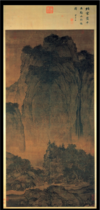Test 2 Essay's Flashcards

Tomb of Emperor Qin, 3rd century BCE, China, Qin Dynasty
Statues were made of terracotta. Uncovered 7,000 soldiers, with a possible total of 10,000 soldiers. Each warrior is individualized. They have different hairstyles and faces. When they were made, it was painted with bright colors, but the process of oxidation has left the colors faded. Tomb is entirely underground and is as large as a city. Top of tomb is concealed under dirt. Much of the tomb has not been excavated because of high mercury levels in the ground. Ancient writings were found describing the tomb as being surrounded by a river of mercury. It was thought to be fictitious, but may be true due to the discovery of mercury in the ground.

Grand Shrine, Ise, Founded in Kofun Period, 3rd century CE, Japan, Shinto shrine
Shrine houses the mirror of the Sun Goddess Amaterasu. Reconstructed every 20 years. Trees are cut down in spring and left there so that the “kami” in the tree can find a new home. Logs are rubbed with persimmon juice, to give a rich gold-brown color. The top of shrine has a layer of gold. People are not allowed in shrine. Japanese royal family are connected to the shrine and the females are priestesses.

Rukupo, Interior of Te Hau-ki-Turanga Meeting-house, Poverty Bay, New Zealand. Maori. 1842-45, restored 1935.
Made of wood, shells, grass, flax, and pigments. When Rukupo was made chieftan, he built this meeting house and dedicated it to his brother, who was the chieftan before him. Meeting houses were built for the purpose to have discussions about how to deal with Westerners and other important things. This particular meeting house featured a roof that represented the sky God along with rafters that represented the sky God’s ribs. Tiki’s held up the rafters and also represented ancestors. The brown floor represents mother Earth. Seems likely that the design of the house was influenced by Christian churches. Rukupo used finer Western tools to carve and build this meeting house. Rukupo was later contracted by Westerners to design a church for them, but decided that his designs were too pagan and made Rukupo change it. Meeting houses are meant to decompose and go back to nature but this particular one was preserved in the National Museum of New Zealand.

Fan Kuan, Travelers Amid Mountains and Streams, c. 990-1030, China, Song Dynasty
Used by Buddhists to meditate and therefore imagine that they themselves were one of the travelers making their way up the mountain. They would meditate on life in general. The stamp on the top signifies who owned it.

Katsushika Hokusai, The Great Wave of Kanagawa, from Thirty-Six views of Mt. Fuji, c. 1823-39, Japan, Edo
Carved into woodblock. Only a handful of woodblocks used specifically because of the varying colors. All the whites were carved into one block, and all the blues were carved onto a separate block. Registry stamp on upper-left corner. Hokusai thought Mt. Fuji would give him a long life through his worshipping of it. Hokusai lived longer than his average contemporaries. The boat represents how Japanese people have struggled, but will always perservere.

